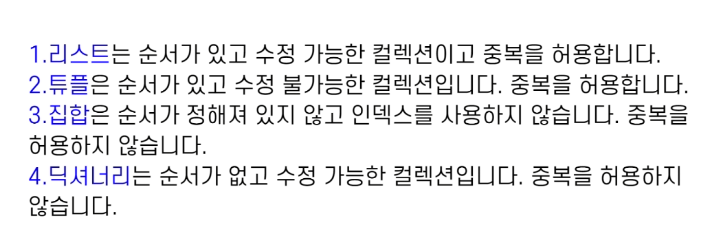728x90
728x90
dictionary(사전)
특정 키에 맞는 value를 가지는 것들이 딕셔너리의 요소들
기본형
sd={
"name":"윤",
"직업":"편집자",
"나이":20
}
print(sd)
print(type(sd))
#{'name': '윤', '직업': '편집자', '나이': 20}
#<class 'dict'>
예
person={
"이름":"김",
"나이":10,
"집":False,
"취미":{"잠","음악감상"}
}
print(person) #{'이름': '김', '나이': 10, '집': False, '취미': {'음악감상', '잠'}}
print(person["나이"]) #10
print(person[0]) #error
키, 값 출력
person={
"이름":"김",
"나이":10,
"집":False,
"취미":{"잠","음악감상"}
}
print(person.keys())
print(person.values())
#dict_keys(['이름', '나이', '집', '취미'])
#dict_values(['김', 10, False, {'잠', '음악감상'}])
추가
person={
"이름":"김",
"나이":10,
"집":False,
"취미":{"잠","음악감상"}
}
person["신장"]=170
person["주소"]="서울시"
print(person)
#{'이름': '김', '나이': 10, '집': False, '취미': {'잠', '음악감상'}, '신장': 170, '주소': '서울시'}
항목을 튜플로 변환
person={
"이름":"김",
"나이":10,
"집":False,
"취미":{"잠","음악감상"}
}
print(person.items())
#dict_items([('이름', '김'), ('나이', 10), ('집', False), ('취미', {'음악감상', '잠'})])
중첩 딕셔너리
person={
"김" : {"결혼":False, "나이":29},
"박" : {"결혼":True, "나이":25}
}
print(person) #{'김': {'결혼': False, '나이': 29}, '박': {'결혼': True, '나이': 25}}person1={
"이름":"김박",
"나이":29
}
person2={
"이름":"김민",
"나이":28
}
person={
"첫째" : person1,
"둘째" : person2
}
print(person) #{'첫째': {'이름': '김박', '나이': 29}, '둘째': {'이름': '김민', '나이': 28}}

728x90
728x90
'Python > 내 손으로 파이썬!' 카테고리의 다른 글
| 코딩엑스 파이썬 8.제어문 - 2.반복문 (0) | 2021.10.05 |
|---|---|
| 코딩엑스 파이썬 8.제어문 - 1.조건문 (0) | 2021.10.05 |
| 코딩엑스 파이썬 7.자료구조 - 3.집합 (0) | 2021.10.05 |
| 코딩엑스 파이썬 7.자료구조 - 2.튜플 (0) | 2021.10.05 |
| 코딩엑스 파이썬 7.자료구조 - 1.리스트 (0) | 2021.10.05 |

